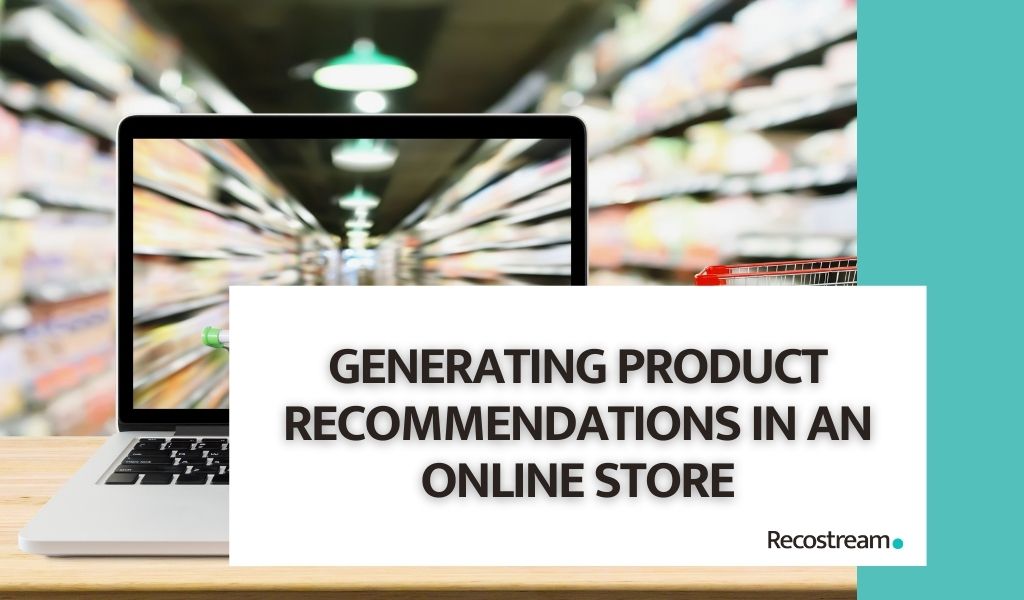Generating Product Recommendations in an Online Store

Product recommendation engines are filtering systems that aim to analyze the collected data and show customers the products they would most likely want to buy.
Recently these systems have been gaining popularity and are now used in various areas of online activity, including streaming services, online bookstores, search engines and product comparison websites.
Today we will cover following issues:
- How come that based on simple data on customer behavior, systems can generate product recommendations ideally suited to customer preferences?
- How do recommendation systems work?
- How are product recommendations generated?
- Is it worth investing in a ready recommendation engine?

How do recommendation systems work?
Systems of personalized product recommendations operate thanks to the use of machine learning techniques.
It is, in a way, a catch-all-phrase, which means using artificial intelligence in order to build algorithms that can adapt to the collected data.
On their basis, the system develops the entire network of connections between customers and the products offered by the online store.
The main goal of building such a system is to make it easier for customers to search for products or content, which in turn translates into increased sales and customer engagement.

Types of data and generating product recommendations
In eCommerce, there are generally 3 types of data that are key to the correct operation of the recommendation generation algorithm:
- Product features - name, price, description, image, category, etc..
- User traffic - visited pages, product pages, products added to the basket, etc.
- User interaction with recommendations - clicks on recommendations.
1. Product features
Based on the first type of data, the algorithm is able to generate recommendations that show similar products based on the similarity of their features.
This is a so-called content-based system that works well in clothing or electronics stores. The advantage of this approach is that the displayed recommendations do not depend on the user behavior on the page, but only on the displayed content.
Thanks to this approach, it is possible to solve the problem of "cold start” resulting from the lack of reliable data on customer behavior at the beginning of the system operation.

Then the first customer will be presented with recommendations that take into account all available products.
A good example of such a solution is the Recostream engine, which, in order to generate recommendations from the "similar" model, analyzes data based on the product description, not the customer's behavior.
2. User traffic on a store’s website
The algorithm that uses data on website traffic will show the user who browses product X also those products that were viewed by other customers with similar behavior on the website.

It is based on the fact that the most frequently clicked products go "up" in the ranking, and the least clicked-on go "down".
You can then remove the least popular products from the recommendation.
3. User interaction with recommendations
The third type of data in the recommendation system is used to optimize and conduct data analysis.
Thanks to this, the store owner can control on an ongoing basis how the recommendations affect sales in the store and which products are the most popular.
Additionally, using this data the system can adjust the order of displayed models depending on their popularity, which results in a better optimization of the tool.
Frequent problems related to building the system of recommendations
Creating your own recommendation system may entail a number of problems and challenges. The first challenge is to process huge datasets to obtain real-time forecasts.
The second problem may turn out to be the lack of information about new users in the system at the beginning of its operation. This problem is usually referred to as "cold start".
Models such as "other customers also viewed" need data on the traffic of many users on the site to work properly.
Therefore, at the very beginning, such a recommendation system will not be able to generate recommended products to customers based on their profiles and preferences.

The "similar products" model is particularly important here as it is based on a content-based system displaying recommendations on the basis of product descriptions and characteristics.
This means that from day one, recommended products may be presented to customers despite the fact of not having a large amount of collected data.
Moreover, methods based on customer behavior are effective but sometimes do not provide enough variety. Again, other models that simultaneously display other types of recommendations can come in handy.
Ready-made recommendation engines - an optimal solution?
It is no surprise that only the largest eCommerce platforms such as Amazon or Alibaba can afford "tailor-made" recommendation systems.
Ready-made solutions in the form of comprehensive recommendation engines come to the rescue of medium-sized online stores.
Taking the Recostream system as an example, the installation of this system boils down to only installing one line of Javascript code on the page, which can easily be done by a person without specialized technical knowledge.
Additionally, the store owner receives access to a panel in which they have access to data on customer behavior and the effectiveness of the entire system.
A system of this type can often turn out to be the most optimal and, at the same time, the simplest solution for medium-sized online stores to boost their sales.
Summary
Product generation using the AI-ruled recommendation engine is a modern and simple solution for every online store. The system that gathers information about product specifications and website traffic is easily accessible and helps you not only increase your sales, but also understand your customers' needs and buying habits.
Personalization of online shopping is a must have and its implementation does not have to be complicated.